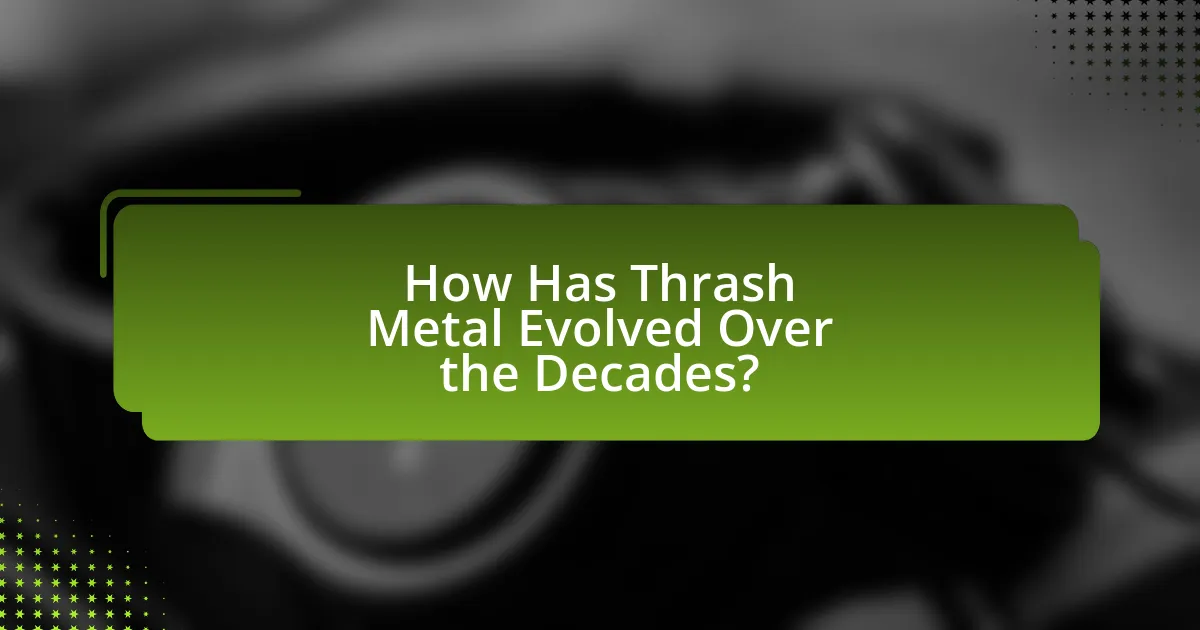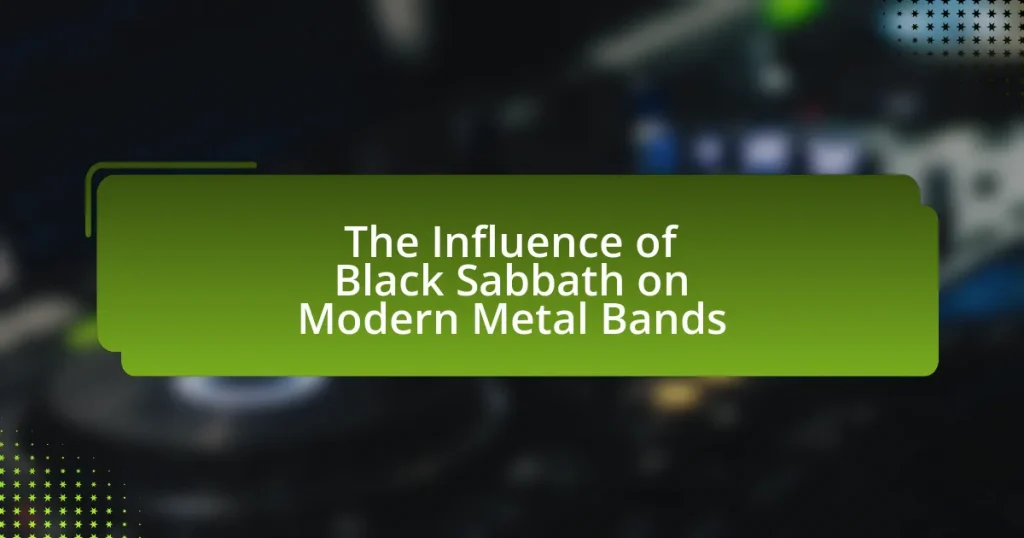Thrash metal is a subgenre of heavy metal that emerged in the early 1980s, characterized by fast tempos, aggressive guitar riffs, and complex song structures. Influenced by punk rock and traditional heavy metal, key bands such as Metallica, Slayer, and Megadeth played significant roles in its development, with seminal albums like “Kill ‘Em All” and “Reign in Blood” setting new standards for the genre. The article explores the defining characteristics of thrash metal, its historical context, the impact of iconic bands, and the evolution of the genre over the decades, including its resurgence in the 21st century and the influence of regional scenes. Additionally, it discusses current trends, the role of live performances, and the future of thrash metal, highlighting how new bands can contribute to its ongoing evolution.

What is Thrash Metal and How Did It Evolve?
Thrash metal is a subgenre of heavy metal characterized by its fast tempos, aggressive guitar riffs, and complex song structures. It emerged in the early 1980s, primarily influenced by the speed and aggression of punk rock and the technicality of heavy metal bands like Iron Maiden and Judas Priest. Key bands such as Metallica, Slayer, and Megadeth played pivotal roles in its development, with Metallica’s 1983 album “Kill ‘Em All” often cited as a seminal release that defined the genre. Thrash metal evolved through the 1980s, gaining popularity and leading to the formation of a distinct subculture, with its themes often revolving around social issues, war, and personal struggles. The genre’s influence can be seen in the emergence of crossover thrash, which blends elements of hardcore punk with thrash metal, further expanding its reach and impact in the music scene.
What are the defining characteristics of Thrash Metal?
Thrash Metal is characterized by its fast tempos, aggressive guitar riffs, and complex song structures. This genre emerged in the early 1980s, combining elements of heavy metal and hardcore punk, which is evident in the music of pioneering bands like Metallica, Slayer, and Megadeth. The lyrical themes often address social issues, war, and personal struggles, reflecting a raw and confrontational style. The genre’s signature sound includes palm-muted guitar techniques and rapid drumming patterns, which contribute to its high-energy performances. Thrash Metal’s influence can be traced through its impact on subsequent metal subgenres and its role in shaping the heavy metal landscape.
How do tempo and rhythm contribute to the Thrash Metal sound?
Tempo and rhythm are fundamental elements that define the Thrash Metal sound by creating a fast-paced, aggressive musical experience. Thrash Metal typically features tempos ranging from 120 to 220 beats per minute, which contributes to its high energy and intensity. The use of rapid, syncopated rhythms, often characterized by palm-muted guitar riffs and double bass drumming, enhances the genre’s aggressive feel. This rhythmic complexity allows for intricate musical passages that maintain listener engagement, while the consistent tempo drives the music forward, creating a sense of urgency. Iconic bands like Metallica and Slayer exemplify these characteristics, with songs such as “Master of Puppets” and “Angel of Death” showcasing how tempo and rhythm work together to establish the Thrash Metal identity.
What role do guitar riffs play in Thrash Metal music?
Guitar riffs are fundamental to Thrash Metal music, serving as the primary driving force behind its aggressive sound and fast-paced rhythms. These riffs typically feature palm-muted chugging, rapid alternate picking, and complex chord progressions, which create a sense of urgency and intensity that characterizes the genre. Iconic bands like Metallica and Slayer have utilized distinctive guitar riffs to establish their signature styles, with tracks such as “Master of Puppets” and “Raining Blood” exemplifying how powerful riffs can define a song’s identity and energy. The technical proficiency required to execute these riffs also contributes to the genre’s appeal, attracting musicians and fans who appreciate the skill involved in Thrash Metal guitar work.
What historical context led to the emergence of Thrash Metal?
Thrash Metal emerged in the early 1980s as a response to the growing dissatisfaction with the mainstream rock and heavy metal scenes. This genre was characterized by its fast tempos, aggressive guitar riffs, and socially conscious lyrics, reflecting the socio-political climate of the time, including economic instability and the rise of youth disillusionment. Bands like Metallica, Slayer, and Megadeth were pivotal in shaping this sound, drawing influence from punk rock’s raw energy and the technical prowess of British heavy metal bands. The convergence of these elements created a fertile ground for Thrash Metal to flourish, as it resonated with a generation seeking authenticity and rebellion against the status quo.
How did punk rock influence the development of Thrash Metal?
Punk rock significantly influenced the development of thrash metal by introducing a fast-paced, aggressive musical style and a DIY ethos. Bands like the Ramones and the Sex Pistols showcased high-energy performances and simple, raw song structures, which thrash metal bands adopted and intensified. The speed and intensity of punk music inspired thrash metal’s characteristic fast tempos and aggressive guitar riffs, as seen in the works of bands like Metallica and Slayer. Additionally, the punk ethos of rebellion and anti-establishment sentiments permeated thrash metal lyrics and themes, further solidifying the connection between the two genres.
What cultural factors contributed to the rise of Thrash Metal in the 1980s?
The rise of Thrash Metal in the 1980s was primarily driven by a cultural backlash against the mainstream music scene, particularly the glam rock and pop genres dominating the era. This genre emerged as a response to the socio-political climate, characterized by disillusionment with authority, economic instability, and the Cold War tensions, which resonated with the youth. Thrash Metal bands like Metallica, Slayer, and Megadeth incorporated aggressive musical styles and lyrics that reflected themes of rebellion, violence, and social issues, appealing to a generation seeking authenticity and intensity in music. The DIY ethic of the punk movement also influenced Thrash Metal, encouraging bands to self-produce and distribute their music, further solidifying its underground roots and cultural significance.
![]()
Which Iconic Bands Shaped the Thrash Metal Genre?
The iconic bands that shaped the thrash metal genre include Metallica, Slayer, Megadeth, and Anthrax. Metallica’s 1983 album “Kill ‘Em All” is often credited with bringing thrash metal to mainstream audiences, while Slayer’s “Reign in Blood” (1986) set a new standard for speed and aggression in the genre. Megadeth, formed by former Metallica guitarist Dave Mustaine, contributed with complex compositions and political themes, particularly in their album “Rust in Peace” (1990). Anthrax, known for their fusion of thrash and punk, gained prominence with their album “Among the Living” (1987). These bands collectively defined the sound, style, and cultural impact of thrash metal during the 1980s and beyond.
What are the most influential Thrash Metal bands?
The most influential Thrash Metal bands are Metallica, Slayer, Megadeth, and Anthrax. Metallica, formed in 1981, revolutionized the genre with their album “Master of Puppets,” which is often cited as one of the greatest metal albums of all time. Slayer, known for their aggressive style and dark themes, released “Reign in Blood” in 1986, which set a new standard for speed and intensity in metal. Megadeth, founded by former Metallica guitarist Dave Mustaine, contributed to the genre with complex compositions and politically charged lyrics, particularly in their album “Rust in Peace.” Anthrax, one of the “Big Four” alongside the other three, helped shape the sound of Thrash Metal with their album “Among the Living,” which is recognized for its blend of thrash and punk influences. These bands collectively defined and popularized Thrash Metal, influencing countless artists and the evolution of heavy music.
How did Metallica redefine Thrash Metal in the 1980s?
Metallica redefined Thrash Metal in the 1980s by incorporating complex song structures, melodic elements, and a more polished production style. Their 1983 album “Kill ‘Em All” established a fast-paced, aggressive sound that was foundational for the genre, while “Master of Puppets” in 1986 showcased intricate arrangements and lyrical depth, elevating the genre’s artistic credibility. Additionally, Metallica’s ability to blend heavy metal with elements of punk rock and classical music expanded the genre’s appeal, leading to mainstream success and influencing countless bands. Their innovative approach set a new standard for musicianship and songwriting in Thrash Metal, solidifying their status as pioneers of the genre.
What impact did Slayer have on the Thrash Metal scene?
Slayer significantly shaped the Thrash Metal scene by pioneering a faster, heavier sound characterized by aggressive guitar riffs and intense drumming. Their 1986 album “Reign in Blood” is often cited as a landmark release that set a new standard for speed and brutality in metal music, influencing countless bands within the genre. Slayer’s lyrical themes, often exploring dark and controversial subjects, pushed the boundaries of what metal could address, further solidifying their role as a key innovator in Thrash Metal. Their relentless touring and performances also helped to popularize the genre, establishing a dedicated fan base and inspiring a wave of new thrash bands in the late 1980s and beyond.
What are the unique contributions of lesser-known Thrash Metal bands?
Lesser-known Thrash Metal bands contribute unique elements to the genre by experimenting with diverse musical styles, lyrical themes, and regional influences. For instance, bands like Coroner and Anacrusis introduced progressive elements and complex song structures, pushing the boundaries of traditional thrash. Additionally, regional bands such as Sepultura from Brazil incorporated indigenous rhythms and themes, enriching the genre’s cultural diversity. These contributions not only broaden the sonic palette of Thrash Metal but also inspire mainstream bands to explore new creative directions, demonstrating the lasting impact of these lesser-known acts on the evolution of the genre.
How did bands like Exodus and Testament influence the genre?
Bands like Exodus and Testament significantly influenced the thrash metal genre by pioneering aggressive musical techniques and lyrical themes that shaped its identity. Exodus, with their album “Bonded by Blood,” introduced fast tempos, intricate guitar riffs, and socially conscious lyrics, setting a standard for thrash metal’s intensity and complexity. Testament furthered this evolution with their album “The Legacy,” which combined melodic elements with thrash’s aggression, showcasing technical proficiency and emotional depth. Their contributions helped establish thrash metal as a distinct genre, influencing countless bands and solidifying its place in heavy metal history.
What role did regional scenes play in the development of Thrash Metal bands?
Regional scenes were crucial in the development of Thrash Metal bands by providing localized support, venues, and a community that fostered the genre’s growth. In the 1980s, cities like San Francisco, Los Angeles, and New York became epicenters for Thrash Metal, where bands such as Metallica, Slayer, and Anthrax emerged. These regional scenes facilitated collaboration among musicians, leading to the creation of a distinct sound characterized by fast tempos and aggressive guitar riffs. The Bay Area Thrash scene, for instance, was instrumental in shaping the genre, with clubs like The Stone hosting early performances that helped bands gain exposure. Additionally, local record labels and fanzines played a significant role in promoting these bands, further solidifying the importance of regional scenes in Thrash Metal’s evolution.

How Has Thrash Metal Evolved Over the Decades?
Thrash metal has evolved significantly since its inception in the early 1980s, characterized by its fast tempos, aggressive guitar riffs, and socially conscious lyrics. Initially popularized by bands like Metallica, Slayer, and Megadeth, thrash metal incorporated elements of punk rock and heavy metal, creating a distinct sound that resonated with fans seeking intensity and rebellion.
In the late 1980s and early 1990s, the genre saw diversification, with bands like Anthrax and Testament introducing melodic elements and complex song structures, while others like Sepultura incorporated influences from other genres, such as Brazilian music. The rise of nu-metal in the late 1990s and early 2000s led to a temporary decline in thrash metal’s mainstream popularity, but the genre experienced a resurgence in the 2010s, with bands like Municipal Waste and Havok reviving the classic sound and attracting a new generation of fans.
This evolution reflects thrash metal’s adaptability, as it has continuously integrated new influences while maintaining its core characteristics, ensuring its relevance in the heavy metal landscape.
What changes have occurred in Thrash Metal since the 1990s?
Since the 1990s, Thrash Metal has evolved significantly, characterized by a resurgence of interest in the genre, diversification of sound, and the emergence of new bands. The late 1990s and early 2000s saw a revival of classic Thrash bands like Metallica and Slayer, who began to incorporate elements from other genres, such as groove metal and hardcore punk, into their music. Additionally, the rise of the internet facilitated the discovery of underground Thrash bands, leading to a broader acceptance and blending of styles within the genre.
By the 2010s, new bands like Havok and Power Trip emerged, revitalizing the Thrash scene with a modern twist while maintaining the genre’s core characteristics. This period also witnessed a resurgence of Thrash festivals and events, further solidifying its place in the metal community. The changes reflect a dynamic genre that continues to adapt while honoring its roots.
How did the grunge movement affect Thrash Metal’s popularity?
The grunge movement significantly diminished Thrash Metal’s popularity in the early 1990s. As grunge bands like Nirvana and Pearl Jam rose to prominence, they shifted mainstream attention away from the aggressive sound and complex musicianship of Thrash Metal, which had been popular in the late 1980s. This transition is evidenced by the decline in album sales and radio play for Thrash Metal bands during this period, as grunge’s raw and emotional style resonated more with the youth of that era. Consequently, many Thrash Metal bands struggled to maintain their fan base and commercial success as the music landscape evolved.
What resurgence has Thrash Metal experienced in the 21st century?
Thrash Metal has experienced a significant resurgence in the 21st century, marked by a revival of interest from both fans and new bands. This resurgence is evidenced by the emergence of numerous new thrash bands, such as Municipal Waste and Power Trip, which have gained popularity and critical acclaim, revitalizing the genre. Additionally, established bands like Slayer and Megadeth have continued to tour extensively, drawing large crowds and introducing thrash to younger audiences. The genre’s influence can also be seen in the crossover with other styles, such as metalcore and punk, further expanding its reach. This renewed interest is reflected in increased album sales and festival appearances, demonstrating Thrash Metal’s enduring appeal and relevance in contemporary music.
What are the current trends in Thrash Metal music?
Current trends in Thrash Metal music include a resurgence of classic sounds, blending with modern elements such as technical proficiency and production quality. Many contemporary bands are revisiting the raw energy and aggression of 1980s Thrash while incorporating influences from genres like metalcore and progressive metal. This trend is evident in the works of bands like Municipal Waste and Power Trip, who maintain the fast tempos and intricate guitar work characteristic of Thrash, while also appealing to a younger audience through energetic live performances and social media engagement. Additionally, there is an increasing focus on lyrical themes that address social and political issues, reflecting the genre’s roots in rebellion and critique.
How are modern bands incorporating new influences into Thrash Metal?
Modern bands are incorporating new influences into Thrash Metal by blending elements from genres such as progressive metal, hardcore punk, and even electronic music. This fusion is evident in the complex song structures and varied tempos that characterize contemporary Thrash, as seen in bands like Havok and Power Trip, which integrate intricate guitar work and diverse vocal styles. Additionally, the use of production techniques from modern metal genres enhances the overall sound, allowing for a more polished and dynamic listening experience. For instance, the album “Nightmare Logic” by Power Trip showcases these influences through its aggressive yet melodic compositions, reflecting a broader range of musical inspirations while maintaining the core essence of Thrash Metal.
What role do festivals and live performances play in the Thrash Metal community today?
Festivals and live performances are central to the Thrash Metal community today, serving as vital platforms for band exposure, fan engagement, and cultural preservation. These events allow fans to experience the raw energy and intensity of Thrash Metal music in a communal setting, fostering a sense of belonging and shared identity among attendees. Major festivals like the “Big Four” (Metallica, Slayer, Megadeth, Anthrax) showcase both legendary and emerging Thrash Metal bands, highlighting the genre’s ongoing relevance and evolution. Additionally, live performances contribute to the genre’s economic sustainability, as ticket sales and merchandise generate revenue that supports artists and venues. The Thrash Metal community thrives on these gatherings, reinforcing connections between fans and musicians while celebrating the genre’s rich history and future.
What can fans expect from the future of Thrash Metal?
Fans can expect Thrash Metal to continue evolving while maintaining its core elements of speed, aggression, and intricate musicianship. The genre is likely to see a resurgence in popularity, driven by a new generation of bands that blend traditional Thrash with modern influences such as metalcore and progressive elements. This evolution is supported by the increasing number of Thrash Metal festivals and the revival of classic bands, which indicates a sustained interest in the genre. Additionally, the integration of digital platforms for music distribution allows emerging Thrash bands to reach wider audiences, further solidifying the genre’s future.
How can new bands contribute to the evolution of Thrash Metal?
New bands can contribute to the evolution of Thrash Metal by introducing innovative sounds, blending genres, and addressing contemporary themes in their lyrics. For instance, bands like Power Trip and Municipal Waste have incorporated elements from hardcore punk and crossover thrash, which revitalizes the genre and attracts a younger audience. Additionally, new bands often experiment with production techniques and song structures, pushing the boundaries of traditional Thrash Metal. This evolution is evidenced by the rise of subgenres like “modern thrash,” which showcases a faster tempo and more complex arrangements, reflecting the influence of digital music production.
What are the best practices for aspiring Thrash Metal musicians?
Aspiring Thrash Metal musicians should focus on mastering their instrument, developing songwriting skills, and understanding the genre’s history. Mastery of guitar techniques, such as fast picking and palm muting, is essential, as evidenced by the technical proficiency displayed by bands like Metallica and Slayer. Songwriting should emphasize aggressive riffs and complex rhythms, which are hallmarks of the genre. Additionally, studying the evolution of Thrash Metal through iconic bands provides context and inspiration, as seen in the works of Anthrax and Megadeth, who have shaped the sound and culture of Thrash Metal. Engaging with the Thrash Metal community through live performances and collaborations can also enhance visibility and growth as a musician.


